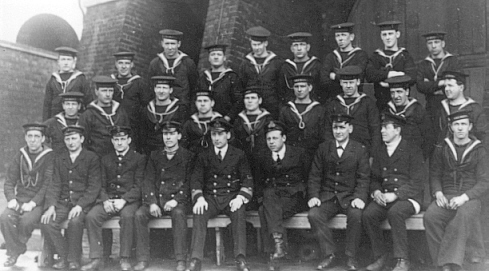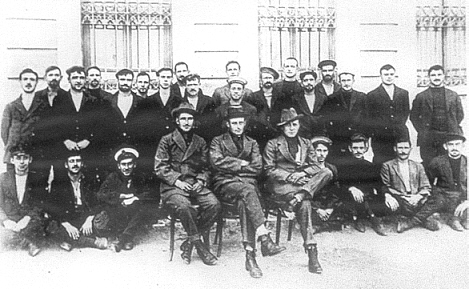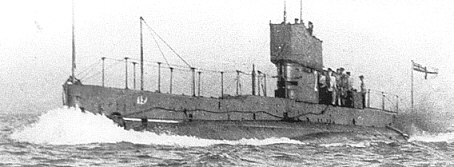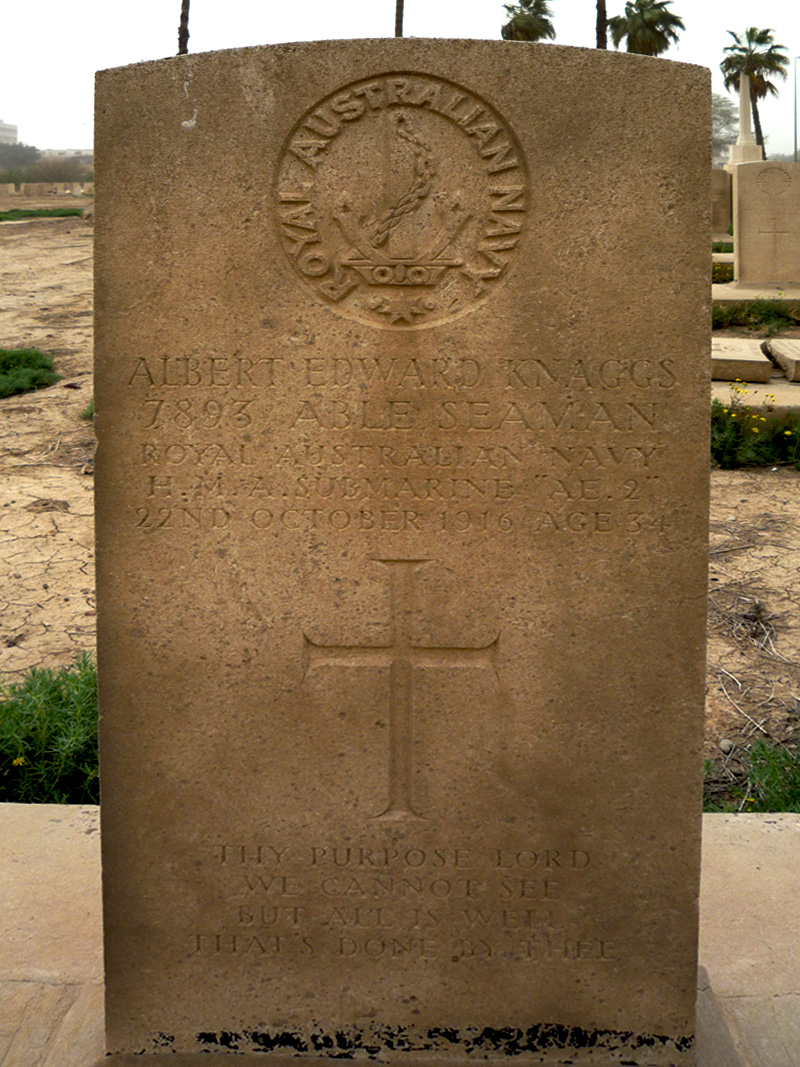
Arrival at Portsmouth Feb 17 1914

Portsmouth before Sailing for Australia.
A E Knaggs, 2nd from left, 2nd row

(thanks to Peter Stoker)

(thanks to John Skelton)

(thanks to Peter Stoker)

(thanks to Colonel Marcus Fielding)
| Home Page |
| Back to the 40's |
 |
| Australian Submarine AE2 Arrival at Portsmouth Feb 17 1914 |
 |
| Crew of HMA submarine AE2 at Portsmouth before Sailing for Australia. A E Knaggs, 2nd from left, 2nd row |
 |
| AE2 crew (thanks to Peter Stoker) |
 |
| AE2 crew when Prisoners of War 22 Dec 1915 (thanks to John Skelton) |
 |
| Australian Submarine AE2 (thanks to Peter Stoker) |
 |
| The headstone marking the grave of Albert Edward Knaggs (Baghdad) (thanks to Colonel Marcus Fielding) |
My father's father was a merchant seaman and travelled the world. In my grandmother's house there was this big chest with an exotic smell - I think it must have been sandalwood. A bell rang when you opened it. I've no idea what it must have contained - I can remember two Japanese prints that nobody wanted!
Some time before the First World War he decided to emigrate to Australia and, so as to secure a free passage for himself and the family, joined the Australian Navy as a submariner. His ship, the imaginatively named AE2, was built in Barrow-in-Furness (in the North-West of England) and her maiden voyage was to sail to Australia - no submarine had previously sailed more than about 400 miles. After various exploits she arrived in Sydney just about in time for the start of the first world war. She saw some limited action in South-East Asia but then returned to Europe to Join the ANZAC forces in the Gallipoli campaign.
On the 25th April, 1915, the ANZACs landed and, after suffering four days of very heavy casualties, were thought to be on the brink of retreating. On that same day the AE2 broke through the Dardanelles and started causing havoc, sinking one Turkish ship. News of this reached the Australian commander who told the troops to keep fighting - only to sustain thousands of casualties. The submarine didn't last long in those treacherous waters and was eventually crippled, and had to be scuttled. The crew were taken captive by the Turks and my grandfather didn't survive the Turkish prisoner-of-war camp. He is buried in the North Gate Cemetery in Baghdad, Iraq.
My grandfather kept a diary of all this which somehow found its way back to Bristol. I inherited it from my father but now it is in the safe keeping (along with his medals) of the Australian Submarine Historical Collection in Sydney. The captain of the AE2 wrote a book of his exploits (with scant mention of the crew) - "Straws in the Wind" by Commander Henry "Dacre" Stoker.
The book "Stoker's Submarine" by Fred and Elizabeth Brenchley contains the following mini biography . . .
Knaggs, Albert Edward; Able Seaman; RN/RAN 7893
A war casualty, Albert Knaggs left an important diary of events up until his death in October 1916. He filled a very small notebook with almost microscopic writing; its value lies in being a contemporary eyewitness record whereas most of the other diaries of AE2 men were written years after the war.Knaggs was born in Bristol, England, on 12 August 1881. At the time he was selected for submarine service in 1912, on loan from the RN to the RAN, he was already an experienced able seaman who had seen service on at least a dozen RN ships.
Taken prisoner from the sinking AE2 on 30 April 1915, Knaggs' diary shows the treatment meted out to the ordinary enlisted men, Protestant and English. Of all the classifications, this grouping was treated the most harshly. In the almost 18 months of captivity before his death, Knaggs was shunted from camp to camp and, from his own account, always seemed to be allocated the heaviest and most difficult tasks.
Jailed first in Constinople, the submariners found themselves, as Knaggs descrived: 'Nearly eaten alive with bugs and lice before supplied with soldier suites, overcoats, slippers and red fezes, marched through the streets of Constantinople to a prison and given food not fit for pigs . . . heads shaved like criminals.' When the men arrived at the camp in Afion Kara Hissar, their problems continued: 'Impossible to sleep at night with the cold and wind . . . packed 32 in a room which would accommodate 16 healthily.'
Knaggs was put to work roadmaking and breaking stones. Without proper clothing or protective footwear, conditions were tough. The men were on near-starvation rations and became progressively weakened. In July Knaggs was given a second, similar assignment. He wrote: 'All English left to work in the country, marching all day, before sleeping in the cold outdoors at night. Then began more roadwork, from sunrise to sunset, on bread and water.' On 14 July he wrote, ominously:' We refused to work.'
This was a dangerous tactic to adopt in the prison camps. Knaggs and his group were sent back to Afion Kara Hissar, but then reassigned to another group of English prisoners who were being shipped by rail to Angora. From there they were marched 80 miles to an old army training barracks in Cankiri, again a cold draughty place full of lice and vermin. All the men arrived there in a weak and exhausted state.
Later Knaggs was shipped back from Cankiri with a group of men who were ill or injured. Some were carried the 80 miles back to Angora by wagon, but others were made to 'march through snow so heavy you wouls sink to your boot-tops'. From there they were put on a heavily overloaded train which headed for Konya, and then continued in the direction of Pozanti in the Taurus Mountains. Knaggs wrote optimistically from there in February: 'Here we are allowed plenty of liberty, no sentries allowed to interfere with us as long as things run smoothly. The work consists of drilling and blasting tunnels, navvying etc . . . The name of this place is Belemedik.'
Shortly after this entry, Knaggs was transferred to labouring work at the sawmills, a less demanding job. He began to report continually on the disease sweeping through the camp, now seriously overcrowded with thousands of prisoners living in sub-standard conditions. Malaria and typhoid fever were rampant, especially in the Russian and French quarters.
At the end of March 1916, he was placed at the First Tunnel camp, working as a cook for German caroenters, and from there was sent at the end of May to Kula Maghera, a Second Tunnel camp along the railway line. It is not known why he was moved around so frequently, more so than any other AE2 prisoner of war. His diary entries end abruptly on 18 July 1916.
Knaggs' poor health may have been one reason for his difficulties as a POW. He had contracted malaria, probably in the first wave of the illness that swept Belemedik in early spring, and although he had been inoculated against typhoid fever at Afion Kara Hissar, he died in the makeshift camp hospital at Belemedik on 22 October 1916. He was buried at Belemedik in the Christian Armenian Cemetery. The Imperial War Graves Commission later relocated his grave to their official Baghdad North Gate Cemetery.
There are links to the AE2 here.......
Submarine Institute of Australia
HMAS AE2 (on Wikipedia)
| Home Page |
| Back to the 40's |